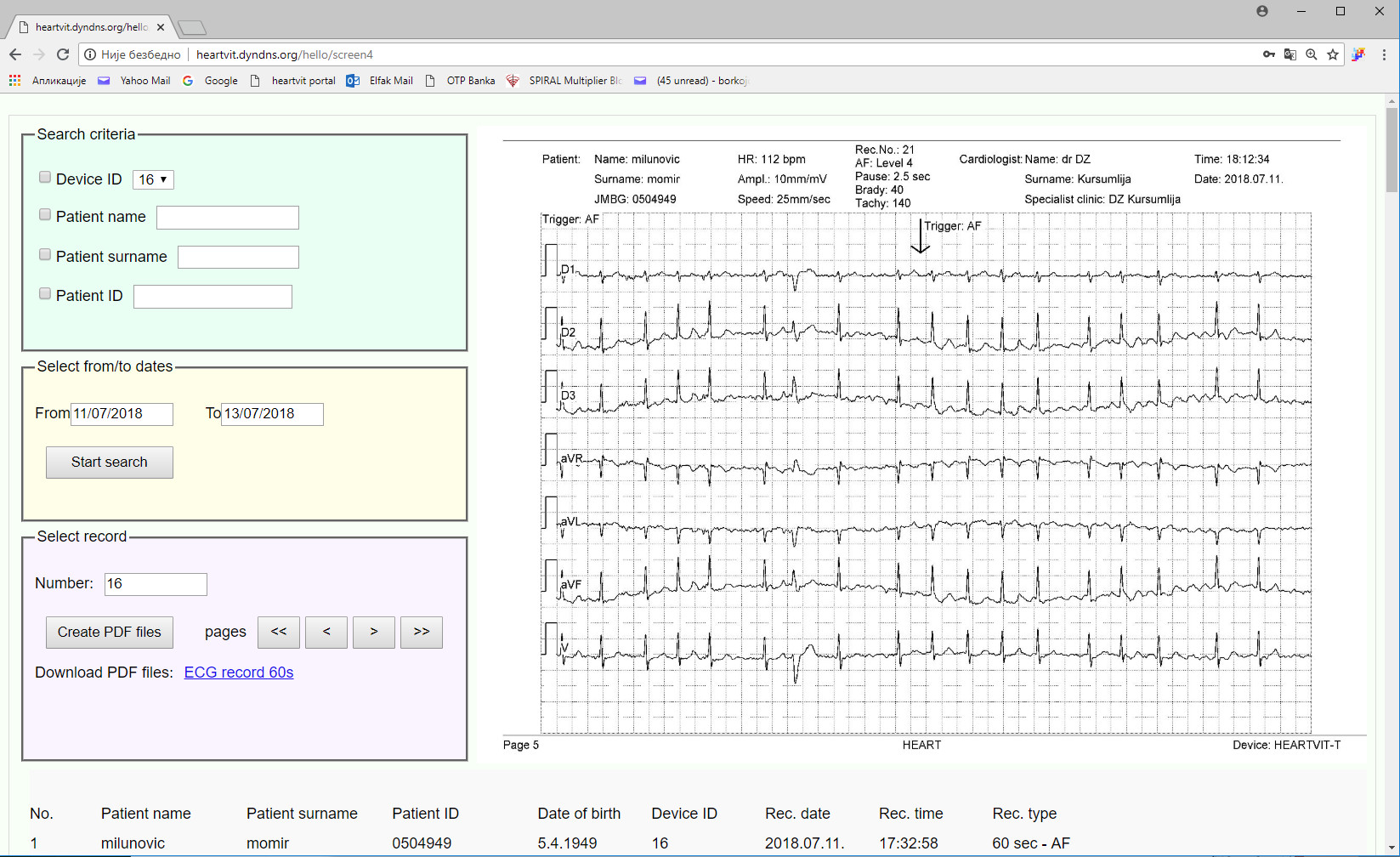 |
 |
| Products: |
Address:
Čarnojevića st. 4/21 18000 Niš
Serbia
Tel.:
+381 18 244282
+381 61 2340396
Email:
borkojov@yahoo.com
|

HEARTVIT-T ECG telemetry system
|
The HEARTVIT-T ECG telemetry allows remote continuous patient monitoring. The patient is in permanent contact with cardiologist, until the cardiac disorders are detected.
The HEARTVIT-T is attached to the patient continously all the time (it may be several days or weeks). It is the main advantage compared to some telemetry devices (toys) which patient takes only when feels symptoms. SIMPLY,TELEMETRY DEVICE MUST DETECT EVERYTHING.
ECG signals are recorded by HEARTVIT-T and transmitted immediatelly to cardiologist's Email (in the form of PDF).
The HEARTVIT-T searches heart rhythm abnormalities. HEARTVIT-T automatically detects bradycardia, tachycardia, pause and arrhythmia and sends relevant ECG recordings to cardiologists.
|
|
|
Who can use HEARTVIT-T?
-
Patients with problems such as loss of consciousness of unknown cause, fainting, dizziness, feeling of palpitations, heart skipping
-
Patients with high cardiovascular risk in the absence of subjective symptoms
-
When identification of ECG changes is required that may cause malignant rhythm disorders
-
For atrial fibrillation (AF) screening: this is one of the leading causes of ischemic brain stroke
-
Patients who are not yet on medication, but need to be monitored.
HEARTVIT-T ECG telemetry system
-
HEARTVIT-T is an ECG telemetry device recording the ECG signals.
-
The ECG is transmitted to the doctor’email for viewing and analyzing.
-
7-channel ECG signal acquisition (standard leads D1-D3,
aVR, aVL, aVF, precordial V)
-
The highest ECG signal quality.
-
ECG reports are sent to doctor's email in PDF form and printed on A4 paper.
PDF ECG recordings are avaliable online through WEB PORTAL.
HEARTVIT-T module characteristics
-
Standard ECG leads acquisition: D1-D3,
aVR, aVL, aVF and one precordial V
-
Analog ECG amplifier bandwidth:
0.05Hz - 100Hz
-
Dynamic range: +/- 5mV
-
Input impedance: >20M Ohm
-
Sampling frequency: 500Hz
-
ADC resolution: 5uV
-
Analog filters: 0.05Hz High pass, 50Hz
Notch, built-in advanced signal filtering
-
Machine learning for QRS detection;lead off detection
-
Device is clinically validated
-
Power supply: two Alcaline or Ni MH AAA batteries
-
Power consumption: 10mW in EVENT mode, 100mW in ONLINE, low power consumption enables 7-day monitoring on single pair of batteries
-
Communication: Bluetooth to the patient's mobile phone, mobile phone internet to the doctor's site
-
Small dimensions: 105x58x18mm
-
Weight: 100g (with battery)
Operating modes
Operating modes: EVENT and ONLINE
-
ONLINE: The device records the ECG signals and transfers them to mobile phone through Bluetooth. The signals are shown on phone display.
After the patient presses the button on phone, an ECG recording (the duration is 10 seconds) with ECG signal analysis is automatically sent to the doctor’s Email in form of the PDF file.
-
EVENT mode: The device continously records and analyzes ECG signals without sending in low-power EVENT mode.
Only when heart rhythm abnormality is detected(atrial fibrillation, pause, bradycardia, tachycardia), one-minute lasting ECG recording is sent to mobile phone over Bluetooth. Then, it is automatically forwarded to the doctor’s Email through internet connection.
VIDEO PRESENTATION
|

Figure 1. HEARTVIT-T telemetry system

Figure 2: ECG recordings sent to doctor's Email

Figure 3. Online ECG database always provided to doctors through Web Browsers
DOWNLOADS
HEARTVIT-T telemetry system
product brief 
.
An example of ECG record with bradycardia detected 
.
ECG record - tachycardia detected 
.
ECG record - pause detected 
. |
Scientific papers
Borisav Jovanovic, Srdan Milenkovic and Milan Pavlovic, "VT/VF DETECTION METHOD BASED ON ECG SIGNAL QUALITY ASSESSMENT", Journal of Circuits, Systems and Computers, Vol.27, No.11, 2018
Borisav Jovanovic, Vanco Litovski and Milan Pavlovic, "QRS COMPLEX DETECTION BASED ECG SIGNAL ARTEFACT DISCRIMINATION", Facta Universitatis, Series: Electronics and Energetics, Vol.28, No.4, 2015,
|
|




